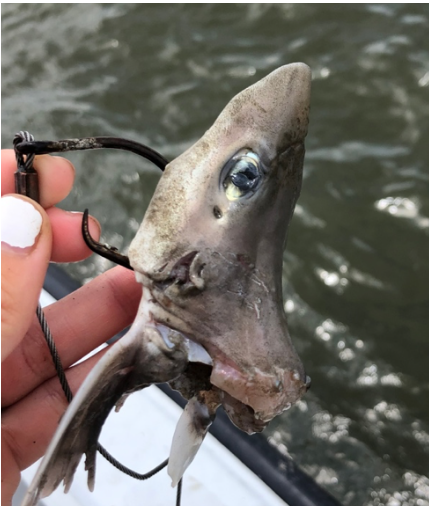Rishworth, G. M., R. Perissinotto, T. G. Bornman, and D. A. Lemley, 2017, Peritidal stromatolites at the convergence of groundwater seepage and marine incursion: Patterns of salinity, temperature and nutrient variability, Journal of Marine Systems 167:68-77. http://doi.org/10.1016/j.jmarsys.2016.11.010
Opportunities to study stromatolites, layered forms of ancient microbial structures called microbialites, are few and far between. They only occur in a few places around the world, including South Africa, where Rishworth et al. examined the conditions that support stromatolites. Considering the limited understanding and rarity of intertidal stromatolites, this research has potential to shed light on microbial processes and their role in shaping biological coastal communities.
What in the world is a microbialite?
Microbialites are reef-like structures, often referred to as “living rocks”, made of calcium carbonate and are inhabited by diverse communities of bacteria, algae, cyanobacteria, and diatoms. They form their own mini-ecosystem, and primarily occur in salty shallow environments, but a few microbialites occur in the intertidal zone, experiencing great fluctuations in salinity, nutrients, and temperature of the water.

Microbialite formation and long-term survival requires adequate levels of calcium carbonate, as this compound forms the “backbone” of the biological communities that interact with them. In seawater, calcium carbonate goes between solid and dissolved phases; how much of it stays in the solid form depends on a number of factors, including salinity, nutrient concentration, and temperature of the water. Thus changes to any of these parameters in local water conditions can significantly impact microbialite formation and the communities that thrive on them.
The study
A layered form of microbialites called stromatolites occurring along the coast of South Africa at Cape Morgan live at the interface of constant groundwater seepage and tidal or storm-induced seawater flooding and experience constantly fluctuating water conditions. The researchers went on a quest to identify the role of salinity, temperature, and nutrients in structuring stromatolites in this unique and variable setting.

The study site
This study took place at three sites (see the map, below) along a gradient of low to high human influence. At each site, the researchers identified three zones from which to sample:
1) upper pools that receive continuous inflow from groundwater seepage;
2) middle pools that receive upland and ocean inputs, and;
3) lower, seaward pools receiving ocean water.

What data did they collect?
The researchers continuously monitored temperature and salinity at each zone within the three sites over the course of one year. They also measured dissolved inorganic nitrogen (DIN; such as ammonium), and dissolved inorganic phosphorus (DIP; phosphates), pH, and dissolved oxygen.
They analyzed the data to look for differences in patterns of salinity, temperature, and nutrients among the three sites and among the three zones within each site.
Results:
The role of nutrients
The researchers observed a clear trend of increasing DIN and DIP concentrations at sites with higher levels of human influence. Freshwater provided the main source of DIN, and upper pools had higher DIN concentrations than lower pools. While freshwater provided nitrogen, an important nutrient for building proteins, seawater provided phosphorus to the lower and middle pools. DIP is important for stromatolites because the availability of phosphorus often limits algal growth. They also found that DIN decreased from the upper pools to lower pools, likely due to these nutrients being used by photosynthesizing algae and cyanobacteria.
Salinity is key
Stromatolites within the main pools, where the greatest influence of tides occurred, experienced the greatest fluctuations in salinity, with conditions ranging from freshwater, brackish, to marine. Imagine being a barnacle living through such a wide range of salinity; for you and me, that would be analogous to experiencing all four seasons in 24 hours! Different algal and bacterial species have their own tolerances to salinities, which means that the swings in salinity within the middle pools can “turn the tables” as to which species dominates in the stromatolites. This fluctuating salinity also benefits the stromatolites by keeping away hungry invertebrates that could chow down on the nutritious algae growing on the stromatolites. The degree to which salinity fluctuates, rather than just the absolute salinity, is important in sustaining the stromatolite community.
The Big Picture
As more development occurs along the coastline, increased pollution could threaten the persistence of these rare ecosystems. Especially in stromatolite pools closer to human influences, higher nutrient runoff could alter the balance in the microbialite-forming communities. Understanding the conditions in which stromatolites form and thrive furthers our understanding of their role in coastal ecosystems and how it might change in the future. This in turn can help inform conservation efforts to keep these systems protected in the long-term.
Kate received her Ph.D. in Aquatic Ecology from the University of Notre Dame and she holds a Masters in Environmental Science & Biology from SUNY Brockport. She currently teaches at a small college in Indiana and is starting out her neophyte research career in aquatic community monitoring. Outside of lab and fieldwork, she enjoys running and kickboxing.

